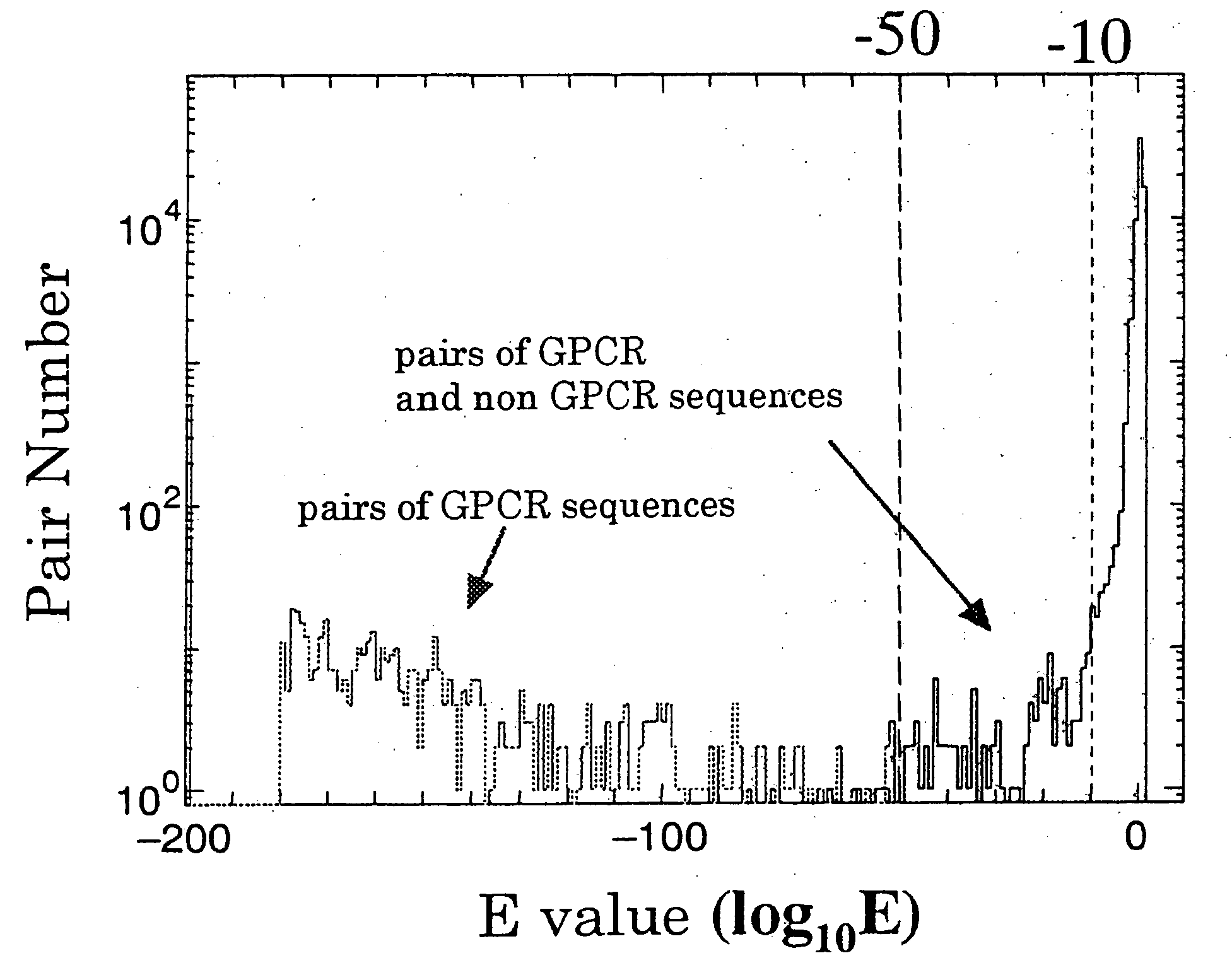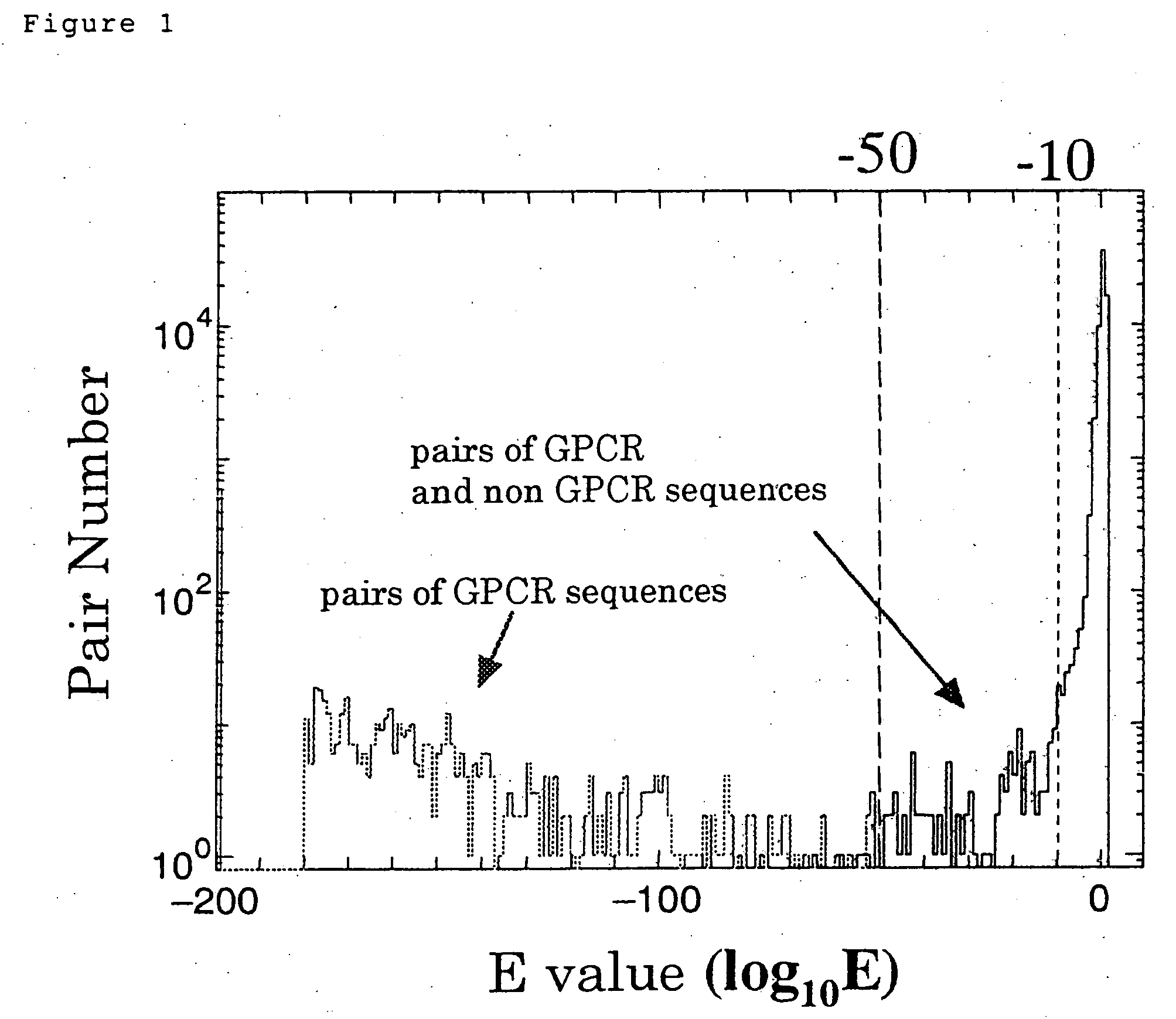Guanosine triphosphate-binding protein coupled receptors
a technology of guanosine triphosphate and coupled receptors, which is applied in the field of polypeptides, can solve the problems of limited number of novel genes, and achieve the effect of efficient extraction of gpcr sequences
- Summary
- Abstract
- Description
- Claims
- Application Information
AI Technical Summary
Benefits of technology
Problems solved by technology
Method used
Image
Examples
example 1
Extraction of Amino Acid Sequences from Human Genome Data
[0190] In the first step for discovering novel GPCR genes (i.e., sequence extraction), the present inventors selected all candidates of the 6-frame translation sequences (6F development sequence), which exist between the initiation codon and termination codon in human genome sequences. When a plurality of initiation codons (ATG) are found on the same sequence, the initiation codon giving the longest sequence was selected. On the other hand, in order to detect sequences containing plural exons, protein-coding regions (GD sequence) were discovered using the gene discovery program (GeneDecoder) (Asai, K., et al., Pacific Symposium on Biocomputing 98, pp. 228-239 (PSB98, 1998)). Since a GPCR protein contains seven transmembrane helices with a length of about 20 residues, the condition for both sequences was set to comprise 150 residues or more (>20*7).
[0191] 375,412 sequences by 6-frame translation and 95,900 sequences by the Ge...
example 2
Triple Analysis
[0193] BLASTP (Altschul, S. F. et al., Nucleic Acids Res. 25, 3389-3402 (1997)) for searching sequences; PFAM database (Bateman, A., et al., Nucleic Acids Res. 2:8,-263-266-(2000)) and PROSITE databases (Bairoch, A., Nucleic Acids Res. 20, Suppl: 2013-2018 (1992)) for assigning domains and motifs; and TMWindows, which is a unique algorithm written by the present inventors, and further, Mitaku method (Hirokawa, T., et al., Bioinformatics. 14, 378-379 (1998)) for predicting TMH were used in the triple analysis. Specifically, the inventors carried out the triple analysis as follows:
[0194] (1) Amino acid sequences (6F development sequences, GD sequences) obtained in the sequence extraction step were searched in SWISSPROT database using BLASTP, and sequences which coincide with known GPCR sequences with an E-value of −10 or 10−50 were selected.
[0195] (2) Sequences wherein a GPCR-specific domain in PFAM database could be assigned with an E-value of −10 were selected from...
example 3
Accurate Selection of the Number of Genes
[0208] GPCR candidate substances were screened from sequences generated in the first step, using the thresholds shown in Table 1. However, since these sequences contained following duplicated examples, it was required to finally select rigidly the number of candidates.
PUM
| Property | Measurement | Unit |
|---|---|---|
| temperature | aaaaa | aaaaa |
| temperature | aaaaa | aaaaa |
| pH | aaaaa | aaaaa |
Abstract
Description
Claims
Application Information
 Login to View More
Login to View More - R&D
- Intellectual Property
- Life Sciences
- Materials
- Tech Scout
- Unparalleled Data Quality
- Higher Quality Content
- 60% Fewer Hallucinations
Browse by: Latest US Patents, China's latest patents, Technical Efficacy Thesaurus, Application Domain, Technology Topic, Popular Technical Reports.
© 2025 PatSnap. All rights reserved.Legal|Privacy policy|Modern Slavery Act Transparency Statement|Sitemap|About US| Contact US: help@patsnap.com


